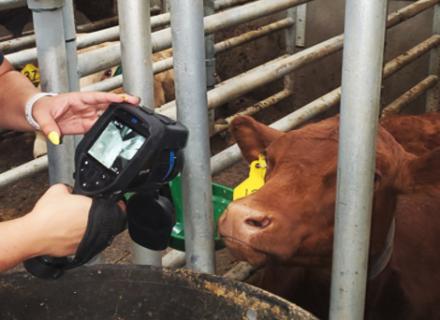The ‘Eyes’ Have It

A researcher uses a special infrared camera to take the temperature of a cow. (Photo by Kristin Hales)
Rapid Fever Detection Improves Cattle Health, Reduces Cost
Researchers in Texas are applying technology normally used on humans to determine which members of a herd of cattle are sick and in need of treatment. The result is greater animal health care at lower production cost. It also helps fight a global health issue.
Scientists at the Agricultural Research Service's (ARS) Livestock Issues Research Unit (LIRU) in Lubbock, TX, are using a special camera to look into the eyes of each cow being processed through the feedlot. The camera uses infrared technology to accurately measure the heat produced by the cow's eye.
Infrared scanning takes 20-30 seconds per animal and replaces the traditional method of using rectal thermometers, which takes up to 2 minutes per animal.
"When humans are not feeling well, we are quick to grab our thermometers, typically using an infrared forehead thermometer to check for a fever," said Nicole Sanchez, an animal scientist at LIRU. "In animals, our go-to method [was] a rectal temperature. However, recent studies in our laboratory have found that using a special camera to measure the infrared temperature of the eye can be just as accurate."
Sanchez said that body temperature measurement is important when considering treating an animal. "It is possible to use this technology for the targeted treatment of cattle that have a fever, rather than treating all cattle with antibiotics, a method termed 'metaphylaxis.' This would reduce the number of cattle treated with antibiotics."
According to Rand Broadway, microbiologist at LIRU, metaphylaxis is the practice of administering antimicrobials to an entire herd to prevent the spread of disease if there is disease present. By quickly and accurately measuring fever in cattle, producers can target treatment to only those cattle that have a fever, which can reduce the use of antibiotics.
This is an important consideration because the general overuse of antibiotics has caused an urgent global public health threat known as antimicrobial resistance (AMR). According to the Centers for Disease Control and Prevention, AMR occurs when germs develop the ability to defeat the drugs that are designed to kill them. More than 2.8 million antimicrobial-resistant infections occur in the United States each year, resulting in more than 35,000 deaths.
According to Jeff Carroll, research leader of the LIRU group, using a targeted treatment approach also makes sense economically – potentially reducing the amount of antibiotics and saving producers a lot of money. LIRU's collaborative effort with scientists from Texas Tech University found that targeting antibiotic treatment to only those calves exhibiting a fever decreased treatment cost per calf by approximately 45%, from $26.51 to $13.92.
"The savings associated with reduced treatment costs could ultimately reduce consumer costs and improve animal end products," Broadway said. – by Scott Elliott, ARS Office of Communications
Also in our series on cattle:

